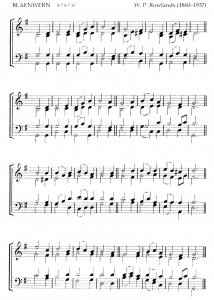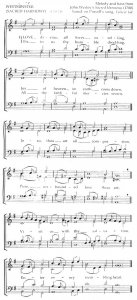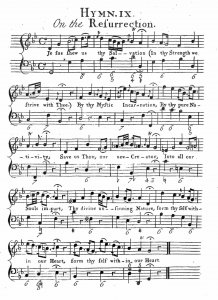Hymns
Hymns
Unlike the psalms chanted in anglican worship, such hymns as were sung among Dissenters and Methodists were not mere translations of Scripture, but original poetry. John Wesley’ s brother Charles is generally assumed to have composed at least 8,000 hymns.
Whatever the metre, each syllable in the text should be set to a single note in the tune, in order to conform with the Protestant tradition of monosyllabism, whereby the words matter as much as the tune. However, the influence of baroque music provided several exceptions to the rule, e.g. Come Holy Spirit and O Jesus, Source of Calm Repose.
The common practice of lining out, a remedy to illiteracy, treated each line as a single entity. Besides, rhymes made it easier for congregations to memorise verse that epitomised their author’s theology. Gradually and imperceptibly, even illiterate people would easily commit many lines to memory.
Within a few decades, such hymns became a most popular element of dissenting and methodist worship, playing a major part in the building up of a specific nonconformist culture and identity.
Over the years, both text and music underwent many changes, so that twentieth-century books do not print hymns exactly as they were originally written in the eighteenth century. One of the most obvious examples of such textual and musical instability is to be found in Love divine, all loves excelling....
Organ
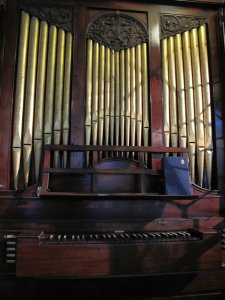
- Charles Wesley’s organ
- Charles Wesley’s organ, at Wesley’s House and Chapel.
[click on the picture to enlarge it]
- Organ
Metre
The rhythmic arrangement of verse in hymns differs from much English poetry, in that it is both syllabic and rhyming:
- common metre (C.M.) defines a four-line stanza or verse where two lines of 8 syllables alternate with two lines of 6 syllables (86.86), as in Come, Holy Spirit
- long metre (L.M.) stanzas or verses are composed exclusively of 8-syllable lines (88.88), as in O Jesu Source of Calm Repose
- a short metre (S.M.) stanza or verse is made up of 6-syllable lines, except for the third line, which has 8 syllables (66.86)
- the popular 87.87 metre, in which 8-syllable lines alternate with 7-syllable lines, is exemplified in Love divine, all loves excelling.
- Come, Holy Spirit
- Linda Pain, Director
Toshiko Baldwin, Pianist
Come Holy Spirit Heav’nly Dove,
With all thy quick’ning Powers
Kindle a Flame of sacred Love
In these cold Hearts of ours.
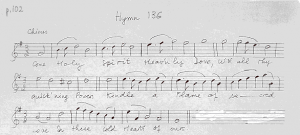
- Come, Holy Spirit
- [click on the picture to enlarge it]
Sacred Melody or A Choice Collection of Psalm and Hymn Tunes, With a Short Introduction, hymn 136 (tune = Chimes) p. 102;
p. 140 in Select Hymns with Tunes Annexed : Designed chiefly for the Use of the People Called Methodists (Bristol : William Pine, 1773).
Here, the Wesleys borrowed their inspiration from a hymn first published by S. Browne in 1720.
The methodist emphasis on congregational singing may explain why such hymns were printed without instrumental accompaniment or four-part harmony.
On the other hand, it is worth noting that hymn writers naturally composed in the musical style of the time, with its typical use of baroque ornamentation, so that one syllable could be associated to several musical notes. Please compare this hymn with Rural Beauty, which is also written in common metre, a metric form that developed from the ballad stanza.
“O Jesu, Source of Calm Repose”
- O Jesu, Source of Calm Repose
- Linda Pain, Director
Toshiko Baldwin, Pianist
O Jesu, Source of calm Repose,
Thy Like nor Man nor Angel knows,
Fairest among Ten thousand fair;Ev’n Those whom Death’s sad Fetters bound,
Whom thickest Darkness compasse’d round,
Find Light and Life if Thou appear. ...
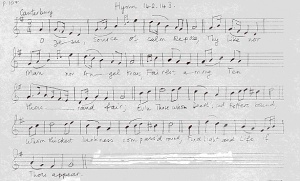
- O Jesu, Source of Calm Repose
- [click on the picture to enlarge it]
Sacred Melody of A choice Collection of Psalm and Hymn Tunes, With a Short Introduction, hymn 142.143 (tune = Canterbury) p. 107; p. 146 in Select Hymns with Tunes Annexed : Designed chiefly for the Use of the People Called Methodists (Bristol : William Pine, 1773).
As was often the case, this hymn was inspired from an earlier tradition; indeed it was translated into long metre from the German Gesangbuch by Anastasius Freylinghausen (1714).
The methodist emphasis on congregational singing may explain why such hymns were printed without instrumental accompaniment or four-part harmony.
On the other hand, it is worth noting that hymn writers naturally composed in the musical style of the time, with its typical use of baroque ornamentation: please compare this hymn with Love divine (2).
- Love Divine (1)
- Linda Pain, Director
Toshiko Baldwin, Pianist
Love divine, all loves excelling,
Joy of heaven, to earth come down,
Fix in us thy humble dwelling,
All thy faithful mercies crown.Jesus, thou art ;all compassion,
Pure, unbounded love thou art;
Visit us with thyvsalvation,
Enter into every trembling heart.
A present-day interpretation with piano accompaniment.
The choir are singing this Wesleyan hymn to one of several familiar, interchangeable, twentieth-century tunes. The original tune may be heard in Love divine (2).
- Love Divine (2)
- Linda Pain, Director
Toshiko Baldwin, Pianist
Love divine, all loves excelling,
Joy of heaven, to earth come down,
Fix in us thy humble dwelling,
All thy faithful mercies crown.Jesus, thou art all compassion,
Pure, unbounded love thou art;
Visit us with thy salvation,
Enter into every trembling heart.
Early Methodists sang this hymn to the well-known tune composed by Henry Purcell to the famous words of Dryden’s paean to Britain, Fairest isle, all isles excelling ...
- Love Divine (3)
- Myriam-Isabelle Ducrocq, Soprano;
Françoise Deconinck-Brossard, Continuo accompaniment;
private recording, Université Paris-Sorbonne.
Originally Charles Wesley had suggested to set the words to a tune composed for another hymn by the German-born composer Jon Fredericke Lampe. However, the musical style made it unsuitable for congregational singing. The ornamented melody for a soloist with figured bass accompaniment would have been more appropriate for a secular use.
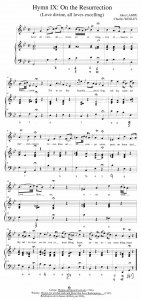
- Love Divine (3)
- Hymn IX: On the Resurrection
(Love divine, all loves excelling)
John LAMPE
Charles WESLEY

